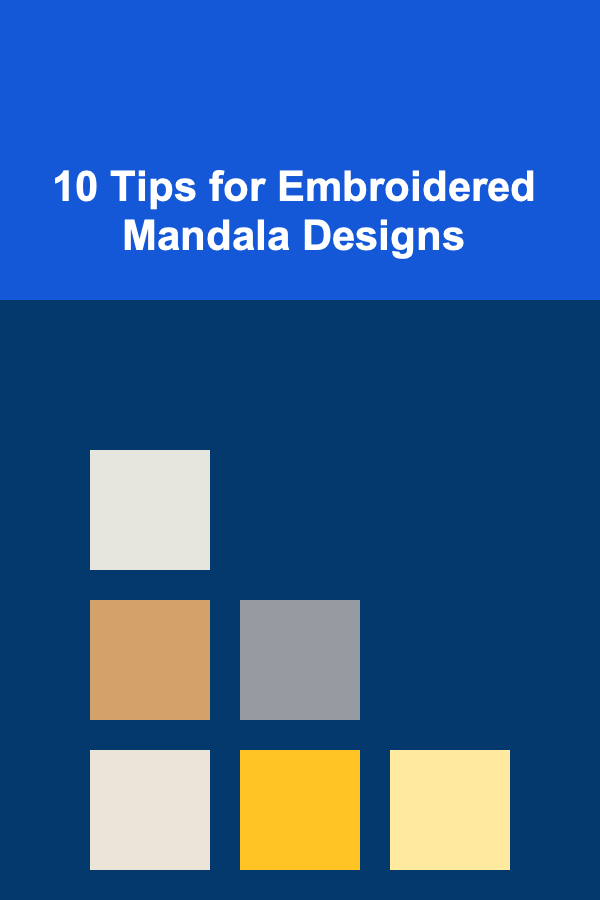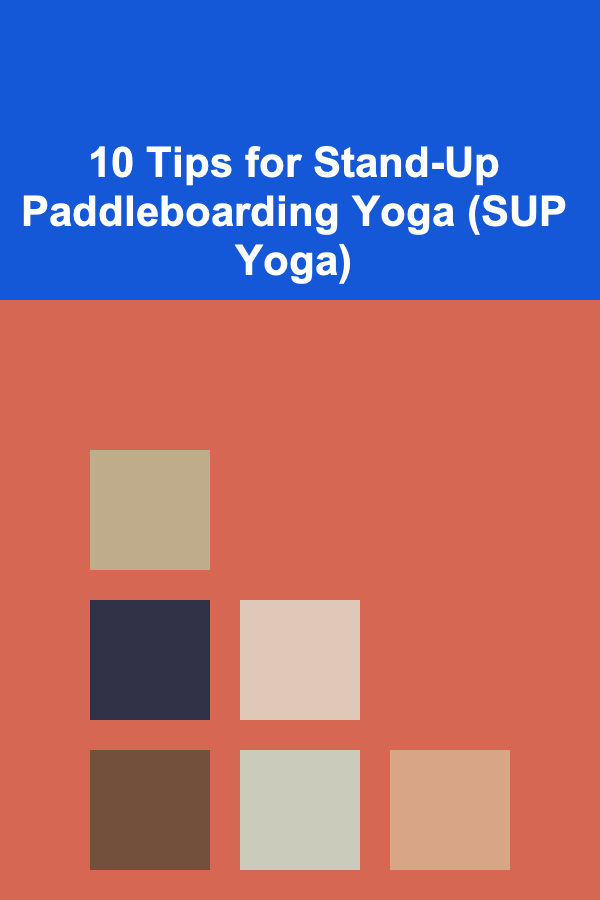
10 Tips for Embroidered Mandala Designs
ebook include PDF & Audio bundle (Micro Guide)
$12.99$9.99
Limited Time Offer! Order within the next:

Embroidered mandala designs are beautiful, intricate works of art that have become increasingly popular among both novice and experienced crafters. The mandala, with its geometric patterns and deep symbolism, provides an ideal canvas for creative expression through embroidery. Whether you're creating a piece for personal use or as a gift, or simply exploring this artistic style, there are several tips to keep in mind to help you perfect your embroidered mandala.
In this article, we will dive into 10 essential tips to enhance your embroidered mandala designs, from understanding the structure of mandalas to mastering embroidery techniques that bring your design to life.
Understand the Meaning and Symbolism of Mandalas
Before you start stitching, it's important to understand the significance of mandalas. A mandala is a geometric figure representing the universe in Hindu and Buddhist symbolism. The word "mandala" itself means "circle," and the design usually incorporates symmetrical patterns radiating from a central point. The circle in mandala designs symbolizes wholeness and unity.
When working on your mandala embroidery, you might want to reflect on these themes of balance, harmony, and spiritual journey. Understanding the meaning behind the patterns can inspire you as you create your piece and help you select colors and shapes that resonate with the symbolism.
Choose Your Design and Colors Carefully
The beauty of mandalas lies in their intricate details and symmetry, so choosing the right design and color palette is key to bringing your embroidered mandala to life.
- Design: There are many different styles of mandalas, from simple circular shapes to more complex geometric or floral designs. You can create your own design or use a pre-existing pattern. If you're creating your own design, consider starting with a basic circular framework and add layers of repeating patterns. The repetition and symmetry will make it easier to stay organized as you stitch.
- Color Palette: Mandalas often incorporate vibrant, bold colors, but you can adapt your color choices based on the style you're aiming for. Choose colors that complement each other and create a sense of balance. Earthy tones like greens and browns convey calmness and stability, while bright colors like red, orange, and yellow bring energy and warmth to your work.
Start with a Strong Foundation: Drawing the Mandala
A well-drawn mandala is the foundation of your embroidery, and it's essential to have a clear outline to follow. You can either draw the mandala freehand or use a compass to create perfect circles and divide them into equal sections. If you're using a pattern, trace the design onto your fabric using a fabric pen or a water-soluble marker.
- Circle Divisions: Divide the circles into sections like wedges or spokes to help you keep the symmetry intact as you stitch. These divisions can serve as guidelines to help you stay consistent with your embroidery.
- Consistency: Make sure your lines are even and symmetrical. Any irregularities in the outline can result in an uneven final design, so take your time during this step.
Select the Right Fabric
Choosing the right fabric is crucial for a successful mandala embroidery project. You want a fabric that is durable and easy to stitch on, yet still provides enough texture to show off your stitches. Some good fabric choices for mandala embroidery include:
- Cotton: A smooth, breathable fabric that's ideal for most types of embroidery.
- Linen: A slightly heavier fabric with a more textured surface, perfect for intricate designs.
- Canvas: For a more rustic or bohemian look, canvas provides a sturdy base for embroidery.
Ensure the fabric is tightly woven and not too loose, as this will allow your stitches to stay neat and consistent.
Use the Right Thread for the Job
The thread you choose plays a significant role in the final look of your embroidered mandala. The two most common types of embroidery thread are:
- Floss: Standard embroidery floss, made up of six strands of thread, is a popular choice for most mandala designs. It's easy to work with and comes in a wide range of colors. You can separate the strands for finer detail or use all six strands for a bolder look.
- Cotton Thread: For a more vintage or textured finish, you might prefer using single-strand cotton thread.
Choose a thread that contrasts well with the fabric color, ensuring that your design will stand out. Metallic or specialty threads, such as gold or silver, can also add a unique touch to the mandala, especially in the center or around the borders.
Experiment with Different Stitching Techniques
Mandala designs are composed of a variety of shapes and textures, and experimenting with different stitches can add dimension and interest to your embroidery. Here are some stitching techniques that work well for mandala designs:
- Back Stitch: Great for outlining geometric shapes or adding fine details.
- Satin Stitch: Perfect for filling in areas with solid color. This stitch provides a smooth, shiny finish that works well for large sections.
- French Knots: These are fantastic for adding texture and dimension. Use them to create little decorative dots or highlights throughout the mandala.
- Chain Stitch: Adds texture to your design and works well for outlining or adding depth to circles.
- Whipped Back Stitch: Ideal for adding a textured, raised effect along edges or curves.
Experimenting with different stitches for different sections of your mandala allows you to create contrast and keep the design dynamic.
Work in Layers
Embroidery is often easier to execute in layers. Instead of trying to stitch everything at once, break your mandala down into smaller sections, stitching one layer at a time. Start with the outermost circle and work your way in, adding details as you go.
- Outer Layers: These are typically larger and can be filled in with broad stitches or patterns like satin stitch or long and short stitches.
- Inner Layers: These require more detail and finer stitching techniques like back stitch, French knots, or even beading.
By working in layers, you'll have better control over the design and can easily adjust sections as you go.
Take Your Time with Symmetry
Symmetry is the key to creating a balanced and visually appealing mandala design. Since the mandala is inherently symmetrical, maintaining this balance throughout the design is essential. Take your time to ensure that each section mirrors the others perfectly.
- Check Alignment: Periodically stop and check your progress. Ensure that your design remains centered and balanced. A small mistake early on can compound as you add more layers, so it's important to correct errors as they occur.
- Use a Grid: If needed, create a grid to help with alignment. The grid will help you maintain proper spacing between sections and ensure each part of your mandala is aligned properly.
Add Unique Details for a Personal Touch
While mandalas have traditional designs, there's plenty of room for creativity. Adding small, unique details can make your design stand out and reflect your personal style. Here are some ideas:
- Beading: Add beads to your mandala to create a sparkling effect in the center or around the edges.
- Sequins: These can enhance the design with texture and shine, particularly in the outer layers.
- Floral Elements: Integrating small floral motifs can add a soft touch to the geometric structure of the mandala.
- Metallic Threads: Using metallic or glitter threads for outlines or small accents can help your design catch the light.
These unique details make your piece feel one-of-a-kind and can enhance the overall effect of your embroidery.
Finish with a Strong Border
A mandala often has a circular shape that can be emphasized by adding a strong, clear border. The border helps frame the design and gives the piece a finished, polished look. You can use a variety of stitches for the border, depending on the look you want to achieve:
- Running Stitch: A simple, subtle border that adds neatness without detracting from the design.
- Whipped Stitch: A thicker, textured border that can highlight the circular shape of the mandala.
- Beaded Border: Adding beads to the border gives the mandala an ornate, finished look.
Finishing your design with a border helps to complete the mandala and draws attention to its intricate details.
Conclusion
Embroidered mandalas are a delightful way to combine art and craftsmanship, offering a relaxing and meditative process that results in beautiful works of art. By understanding the symbolism behind mandalas, choosing the right materials, and experimenting with different stitches, you can create a piece that reflects both your artistic vision and your personal style. Remember to take your time, work in layers, and enjoy the process as you bring your embroidered mandala to life. Happy stitching!
Reading More From Our Other Websites
- [Personal Care Tips 101] How to Use Toner to Refresh Your Skin Throughout the Day
- [Organization Tip 101] How to Build a Custom Storage Solution for Your Needs
- [Home Budget Decorating 101] How to Create a Stylish Home Bar Without Overspending
- [Organization Tip 101] How to Create a Filing System for Important Documents
- [Home Maintenance 101] How to Keep Your Home's Heating System Efficient During Winter
- [Hiking with Kids Tip 101] Preparing for the Trail: A Complete Checklist for Parents and Little Explorers
- [Biking 101] The Ultimate Guide to Women's Bikes: Everything You Need to Know
- [Personal Investment 101] Make Money with Deep Learning Projects: A Step-by-Step Guide
- [Home Holiday Decoration 101] How to Create Adorable and Easy DIY Holiday Crafts for Kids That Double as Decorations
- [Home Security 101] How to Improve Your Home Security with Smart Devices

How to Join Stock Photography Platforms to Sell Travel Photos
Read More
How to Use Labels to Identify Fishing Supplies Easily
Read More
How to Use Secondhand Furniture to Decorate Your Home Stylishly
Read MoreHow to Utilize a House Expenses Excel Sheet for Better Tracking
Read More
Understanding the Global Reach of Esports
Read More
10 Tips for Stand-Up Paddleboarding Yoga (SUP Yoga)
Read MoreOther Products

How to Join Stock Photography Platforms to Sell Travel Photos
Read More
How to Use Labels to Identify Fishing Supplies Easily
Read More
How to Use Secondhand Furniture to Decorate Your Home Stylishly
Read MoreHow to Utilize a House Expenses Excel Sheet for Better Tracking
Read More
Understanding the Global Reach of Esports
Read More